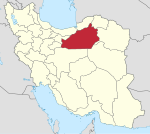Bastam
Bastam
بسطام | |
|---|---|
City | |
 Bayazid Shrine Complex | |
| Coordinates: 36°29′07″N 54°59′59″E / 36.48528°N 54.99972°E | |
| Country | |
| Province | Semnan |
| County | Shahrud |
| Bakhsh | Bastam District |
| Elevation | 1,450 m (4,760 ft) |
| Population (2016 Census) | |
| • Total | 8,609 [1] |
| Time zone | UTC+3:30 (IRST) |
| • Summer (DST) | UTC+4:30 (IRDT) |
| Area code | 0233252 |
| Website | http://www.bastam.ir |
Bastam[pronunciation?] (Persian: بسطام, also romanized as Basṭām; also known as Busṭām and Bisṭām)[2] is a city in and capital of the Bastam District of Shahrud County, Semnan Province, Iran. At the 2006 census, its population was 7,382, in 1,997 families.[3]
Bastam was founded in the 6th century in the Greater Khorasan. It is 6 kilometres (3.7 mi) north of Shahrud. The town is known for its Islamic monuments from the Ilkhanid period and its association with the mystic Bayazid Bastami.[4] The Alborz are to the north of the town.
The 19th-century poet, Abbas Foroughi Bastami, lived in Bastam for a time and thence acquired its name as his own. The early Bábí leader and martyr Mullá ʻAlíy-i-Bastámí was also raised in Bastam, and was a significant figure in the Shaykhi movement and later became the first person known to have died for their allegiance to Bábism.[5]
A tradition says that the town was founded by Vistahm, uncle of the Sasanian king Khosrau II.[6]
See also
References
- ^ https://www.amar.org.ir/english
- ^ Bastam can be found at GEOnet Names Server, at this link, by opening the Advanced Search box, entering "-3055749" in the "Unique Feature Id" form, and clicking on "Search Database".
- ^ "Census of the Islamic Republic of Iran, 1385 (2006)" (Excel). Statistical Center of Iran. Archived from the original on 2011-09-20.
- ^ Bloom, Jonathan M.; Blair, Sheila S., eds. (2009). "Bistam". The Grove Encyclopedia of Islamic Art & Architecture. Vol. 1. Oxford, England: Oxford University Press. p. 291.
- ^ Amanat, Abbas (1989). Resurrection and Renewal. Cornell University Press, New York, USA. pp. 212, 235. ISBN 0-8014-2098-9.
- ^ R. N. Frye, “Bisṭām” Encyclopaedia of Islam, ed. by P. Bearman, et al. (Brill 2008).
External links


